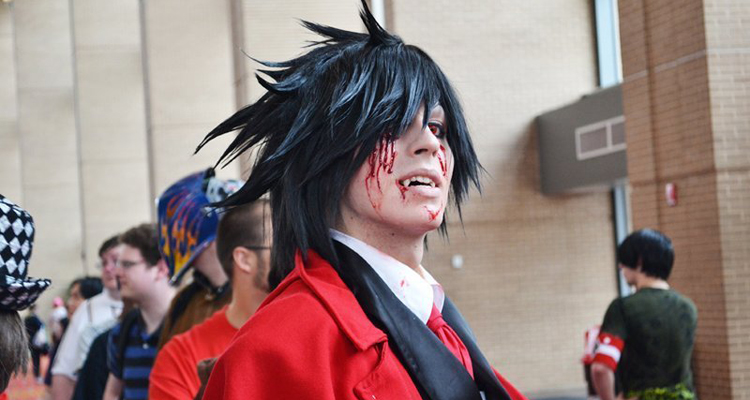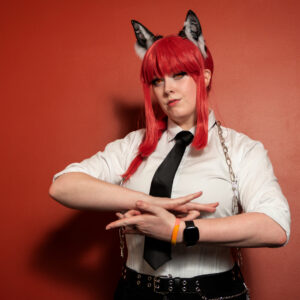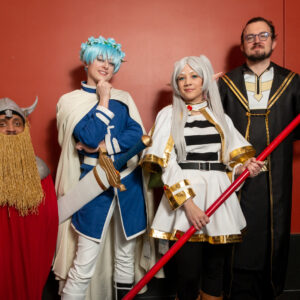Anime Cons: Time To Decide On Branding And Identity

I had just attended AODSF, aka Animation on Demand San Francisco, a scaled, focused convention in Japantown San Francisco. Previously an anime con, it broadened its focus to animation and media, thus changing the meaning of, well, the “A” in its title. Mostly this year it looked like a Homestuck convention with intermediate outburts of anime and pony. Oh and an artist who looked a lot like Benedict Cumberbatch, and was more than glad to cosplay as Sherlock at his art table (note to you sir, you are brilliant).
As I have attended Anime Cons over the years, frankly the focus on Anime has declined, if only by the addition of so many other media. It’s now anime, gaming, webcomics, J-Pop and K-Pop lots of BBC stuff (any moment I expect Downton Abbey magical girl cosplay, and no, I don’t want to think of it), and comics. I’ve speculated on this in the past, needless to say.
So I’d like to return to my previous speculations and focus on just what Anime cons can do with their evolution.
First, there’s no going back. What an “Anime Con” is has changed and gotten amorphous. There’s no back, there’s only through.**
Secondly, I think Anime cons still distinguish themselves identity-wise. Anime cons, though far broader than most conventions, are focused on animation, gaming, comics, and other cutting-edge multi-country media. Anime cons are not science fiction or fantasy, they’re media, often with a heavy artistic component. In short, they really aren’t appropriate to merge into a lot of the other con scenes (though comic cons seem to be turning into something similar).
Going forward is tough – and that’s because of two issues, branding and identity.
Conventions have names associated with them, web domains associated with them, mascots associated with them. How the hell do you embrace your multimedia audience when your convention name is something like “Anime Singularity?” What of the domain name? Changing your name can be disastrous for a conventions attendance as people won’t know what’s going on.
Identity is harder because the anime fan scene is changing and morphing anyway; its identity already is more of a hip multimedia fandom with a strong content creator presence. Trying to embrace it and change your convention’s identity is tough because the identity of the core fandom is so amorphous as well. One screw up and suddenly people aren’t interested.
It probably seems easier to just kind of let things happen. But we all know too well that people attend anime conventions for reasons that may never touch on anime or similar interests, and a con has to know who they are and communicate who they are to keep up and grow attendance. At some point the craziness of this morphing group is going to require conventions to ask “who are we and how do we communicate it.”
So I have a few thoughts on that. That probably doesn’t surprise you.
Decide a Focus:
Anime cons are going to have to decide on their focus, which isn’t going to necessarily be a fun process. Are they tightly focused, are they going broad, etc. I think the calls are going to need to be made in the next 3-5 years – yes, more than I suggested previously.
Whatever focus is chosen, conventions are also going to have to be open to change – because things could be different in 5-10 years. Working adaptability now into the convention identity and organization structure will save a lot of heartache.
Brand Evolution:
The Brand for conventions is going to have to evolve to fit their changes. New catchphrases, different marketing, different website design, etc. With identity determined, the conventions have to figure out how to communicate it.
The real pain in this is the name of the convention and the website. They may be familiar, so a radical change may be a real brand-destroyer.
If you have the name “Anime” in your domain and convention title, then you may have some problems if your focus is going diverse. If your name is more initials like the above AODSF, you can get away with more, like changing what a letter stands for.
This needs to be a plan, and someone or someones has to carry it out. In short, someone on a convention staff just became a brand manager.
Note that – cons need a brand manager.
Planned Transitions:
Transitions of identity and/or brand don’t have to be radical. They can take place over time and let people lessen any destructive impact. If you’re renaming a convention, take 2 years or even 3 to do it so people get used to it. Try new things out. Remap the domain. Tell people about it over time.
Subcon to Main Con:
One idea I’ve kicked around is that if an Anime con has decided it will embrace a more multimedia foundation, it can do that by having a “subcon” that’s broader than anime (and has its own name and website). That subcon can eventually become the “main” con with anime as a subcon or subsection. Eventually the distinction can fade.
Involve People:
Conventions should involve the attendees and even other cons as much as possible. Learn. Meet needs. Make people aware. Get suggestions. That helps make any identity change or rebranding effort more public and more in people’s minds – and something they feel they own.
A sense of “ownership” and being part of a con will help people be part of it – and assist.
The transition is coming. We’ll have to make the call of how cons identity themselves at some point.
Remember: when in doubt, dress like Benedict Cumberbatch.
Steven Savage is a Geek 2.0 writer, speaker, blogger, and job coach. He blogs on careers at http://www.fantopro.com/, nerd and geek culture at http://www.nerdcaliber.com/, and does a site of creative tools at http://www.seventhsanctum.com/. He can be reached at http://www.stevensavage.com/.
* It is not. It is just awesome. Also, it has stuff.
** Also there is no Dana, only Zuul.



